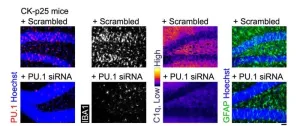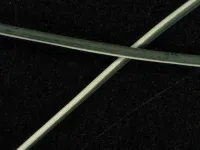(Press-News.org) As holidays near, people are sneaking shakes of their presents to try to figure out what they’re getting. But present shakers might be a little less sly than they think. New research shows it’s incredibly easy for people watching others shake boxes to tell what they’re up to.
“There are few things more delightful than seeing a child’s eyes light up as they pick up a present and wonder what might be inside,” said author Chaz Firestone, a Johns Hopkins University assistant professor of psychological and brain sciences who investigates how vision and thought interact. “What our work shows is that your mind is able to track the information they are seeking. Just as they might be able to tell what’s inside the box by shaking it around, you can tell what they are trying to figure out when they shake it.”
In a series of experiments, the researchers asked hundreds of people to watch others shake boxes. It took just seconds for most of them to know whether the box shaker was trying to learn either how many things were in the box or the shape of things in the box. Although the boxes weren’t presents, and the contents weren’t smart watches, Legos or Red Ryder BB guns, if they were, the results would have been exactly the same, the researchers say.
“The way you would shake a present to find out if it’s one thing or many things, or if it’s a small thing versus a big thing, can be subtly different,” said lead author Sholei Croom, a Johns Hopkins graduate student. “But people are amazing at picking up on such subtleties.”
The deceptively simple work by Johns Hopkins University perception researchers is the first to demonstrate that people can tell what others are trying to learn just by watching their actions. The work, newly published just in time for the holidays in the journal Proceedings of the National Academy of Sciences, reveals a key, yet neglected, aspect of human cognition.
“When we present this work we always talk about Christmas presents,” Firestone said. “It’s the perfect real-life example of our experiment.”
More details on the research here.
MULTIMEDIA AVAILABLE: A GIF of a present-shaking child, matching video clips and stills are available.
END
Science sheds light on shaking your holiday presents
Watching people shake presents reveals little-known quirk of human cognition
2023-12-11
ELSE PRESS RELEASES FROM THIS DATE:
Nanoparticle-delivered RNA reduces neuroinflammation in lab tests
2023-12-11
Some Covid-19 vaccines safely and effectively used lipid nanoparticles (LNPs) to deliver messenger RNA to cells. A new MIT study shows that different nanoparticles could be used for a potential Alzheimer’s disease (AD) therapy. In tests in multiple mouse models and with cultured human cells, a newly tailored LNP formulation effectively delivered small interfering RNA (siRNA) to the brain’s microglia immune cells to suppress expression of a protein linked to excessive inflammation in Alzheimer’s ...
New insight on electrochemical reactions – advancing the green transition
2023-12-11
Electrochemical reactions are central to the green transitions. These reactions use the electric current and potential difference to carry out chemical reactions, which enables binding and realizing electric energy from chemical bonds. This chemistry is the basis for several applications, such as hydrogen technology, batteries, and various aspects of circular economy.
Developments and improvement in these technologies require detailed insight into the electrochemical reactions and different factors impacting them. Recent studies have shown that besides the electrode material also the used solvent, its acidity, and ...
New conductive, cotton-based fiber developed for smart textiles
2023-12-11
PULLMAN, Wash. – A single strand of fiber developed at Washington State University has the flexibility of cotton and the electric conductivity of a polymer, called polyaniline.
The newly developed material showed good potential for wearable e-textiles. The WSU researchers tested the fibers with a system that powered an LED light and another that sensed ammonia gas, detailing their findings in the journal Carbohydrate Polymers.
“We have one fiber in two sections: one section is the conventional cotton: flexible and strong enough for everyday use, and the other side is the conductive material,” said Hang Liu, WSU textile ...
New therapeutic target for rare type of childhood epilepsy
2023-12-11
Researchers at the Francis Crick Institute, UCL and MSD have identified a potential treatment target for a genetic type of epilepsy.
Developmental and epileptic encephalopathies are rare types of epilepsy which start in early childhood. One of the most common types of genetic epilepsy, CDKL5 deficiency disorder (CDD), causes seizures and impaired development. Children are currently treated with generic antiepileptic drugs, as there aren’t yet any disease-targeting medications for this disorder.
CDD involves losing the function of a gene producing the CDKL5 enzyme, which phosphorylates proteins, meaning it adds an extra phosphate ...
Advanced MRI technology detects changes in the brain after COVID-19
2023-12-11
Researchers at Linköping University, Sweden, have examined the brains of 16 patients previously hospitalised for COVID-19 with persisting symptoms. They have found differences in brain tissue structure between patients with persisting symptoms after COVID-19 and healthy people. Their findings, published in the journal Brain Communications, can bring insights into the underlying mechanisms of persisting neurological problems after COVID-19.
Several previous studies of persisting problems after COVID have involved MRI brain scanning. Although researchers have found differences compared with healthy brains, these differences are not specific ...
New study reveals latest data on global burden of cardiovascular disease
2023-12-11
A world without cardiovascular disease (CVD) is possible, yet millions of lives are lost prematurely to heart disease each year, according to the new Global Burden of Disease (GBD) special report published today in the Journal of the American College of Cardiology. The report provides an update of health estimates for the global, regional and national burden and trends of CVD from 1990-2022 by analyzing the impact of cardiovascular conditions and risk factors across 21 global regions.
Research from this study reflects an urgent need ...
Rail industry urged to consider safety risks of space weather
2023-12-11
Train accidents could be caused by solar storms switching signalling from red to green according to new research examining the impact of space weather.
Solar storms can trigger powerful magnetic disturbances on Earth, creating geomagnetically induced currents (GICs) which could potentially interfere with electricity transmission and distribution grids.
A team led by PhD researcher Cameron Patterson and Professor Jim Wild from Lancaster University modelled how GICs flowed through the track circuits of AC electrified lines powered with overhead cables.
Using two routes - the Preston to Lancaster section of the West ...
Technology not growing fast enough to decarbonize steel and cement industries by 2050
2023-12-11
Steel and cement are two materials that no society can do without. Their production comes with a significant carbon footprint, however. To meet zero-emission targets under the Paris Agreement, countries, cities, and industries are depending on new large-scale infrastructure for CO2 transport and storage, renewable electricity and green hydrogen. A new study by researchers at the National Institute for Environmental Studies, Japan, and the University of Cambridge, United Kingdom, shows that the current rate of deployment of this infrastructure is insufficient. The study ...
Landscape for AML patients evolving rapidly as research discoveries advance new treatments
2023-12-11
MIAMI, FLORIDA (EMBARGOED UNTIL DEC. 10, 2023, AT 7:30 P.M. ET) – The treatment landscape for acute myeloid leukemia (AML) is evolving rapidly, as research discoveries at Sylvester Comprehensive Cancer Center at the University of Miami Miller School of Medicine and other academic cancer centers advance new, more effective therapies for this aggressive blood cancer.
“We’ve seen more progress during the past 10 years than the previous four decades combined,” said Justin M. Watts, M.D., Sylvester hematologist, associate professor of medicine, and Pap Corps Early Career ...
'Exceptional' results in phase III leukaemia trial
2023-12-11
University of Leeds news
Embargo: 19:30 ET on Sunday 10 December 2023 / 00.30 GMT on Monday 11 December 2023
New personalised therapy improves survival for patients with CLL leukaemia
Personalised treatment for the most common form of adult leukaemia helps patients survive for longer and stay in remission, a phase III trial has found.
The trial, by the University of Leeds, has been identified as groundbreaking research by the New England Journal of Medicine and the 65th American Society of Hematology (ASH) Annual Meeting and Exposition in San Diego, where ...
LAST 30 PRESS RELEASES:
Making lighter work of calculating fluid and heat flow
Normalizing blood sugar can halve heart attack risk
Lowering blood sugar cuts heart attack risk in people with prediabetes
Study links genetic variants to risk of blinding eye disease in premature infants
Non-opioid ‘pain sponge’ therapy halts cartilage degeneration and relieves chronic pain
AI can pick up cultural values by mimicking how kids learn
China’s ecological redlines offer fast track to 30 x 30 global conservation goal
Invisible indoor threats: emerging household contaminants and their growing risks to human health
Adding antibody treatment to chemo boosts outcomes for children with rare cancer
Germline pathogenic variants among women without a history of breast cancer
Tanning beds triple melanoma risk, potentially causing broad DNA damage
Unique bond identified as key to viral infection speed
Indoor tanning makes youthful skin much older on a genetic level
Mouse model sheds new light on the causes and potential solutions to human GI problems linked to muscular dystrophy
The Journal of Nuclear Medicine ahead-of-print tip sheet: December 12, 2025
Smarter tools for peering into the microscopic world
Applications open for funding to conduct research in the Kinsey Institute archives
Global measure underestimates the severity of food insecurity
Child survivors of critical illness are missing out on timely follow up care
Risk-based vs annual breast cancer screening / the WISDOM randomized clinical trial
University of Toronto launches Electric Vehicle Innovation Ontario to accelerate advanced EV technologies and build Canada’s innovation advantage
Early relapse predicts poor outcomes in aggressive blood cancer
American College of Lifestyle Medicine applauds two CMS models aligned with lifestyle medicine practice and reimbursement
Clinical trial finds cannabis use not a barrier to quitting nicotine vaping
Supplemental nutrition assistance program policies and food insecurity
Switching immune cells to “night mode” could limit damage after a heart attack, study suggests
URI-based Global RIghts Project report spotlights continued troubling trends in worldwide inhumane treatment
Neutrophils are less aggressive at night, explaining why nighttime heart attacks cause less damage than daytime events
Menopausal hormone therapy may not pose breast cancer risk for women with BRCA mutations
Mobile health tool may improve quality of life for adolescent and young adult breast cancer survivors
[Press-News.org] Science sheds light on shaking your holiday presentsWatching people shake presents reveals little-known quirk of human cognition








